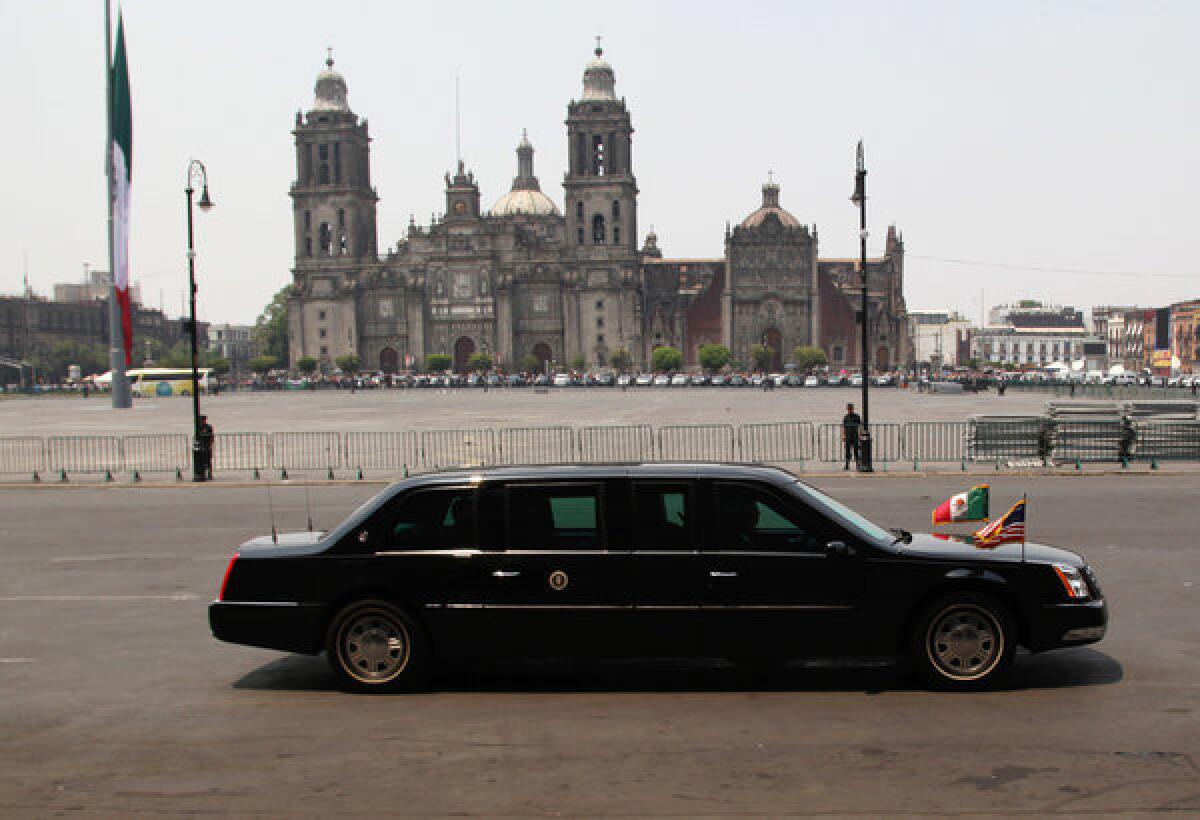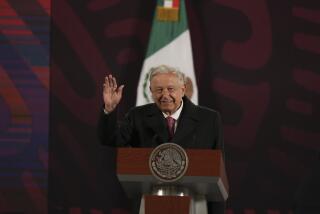In Mexico, an obsession with Obama’s ‘beast’ of a limo

MEXICO CITY — They were tweeting about it, turning it into memes and ogling it in real life along the route that President Obama took from Mexico City’s airport to the colonial front gate of the National Palace.
Throughout Obama’s visit, which ended Friday, the president’s super-armored presidential limousine, nicknamed “The Beast” when it was unveiled four years ago, almost stole the show from the cool and cordial display of diplomacy between Obama and Mexican President Enrique Peña Nieto.
When Obama stepped off Air Force One and hopped into the customized state Cadillac, one cable newscaster on Mexico’s Foro TV called it a “spectacular vehicle.” Broadcasters on a variety of channels seemed to mention The Beast — La Bestia in Spanish — as frequently as they could.
And they were also talking about it in Costa Rica, where Obama was headed after his morning forums with Mexican students and businesses. [Link in Spanish]
Maybe it’s that famed American engineering stirring up the fascination? Or could it have to do with Mexicans’ similar obsession with the popemobile whenever the Holy Father comes to town?
“We came to try to see the car, La Bestia,” said tourist Daniel Castillo, a 33-year-old port worker from Tamaulipas state who was standing outside the National Palace with his wife after Obama and Peña Nieto departed Thursday afternoon. “Don’t really care for ... that señor,” Castillo added, referring to the U.S. president.
News cameramen on motorcycles chased The Beast as it passed some of Mexico City’s toughest neighborhoods along its speediest highways. Infographics on La Bestia adorned news sites, with journalists noting the elaborate features, such as a blood supply in case of an attack. [Link in Spanish]
In a cruel twist, there was another vehicle nicknamed La Bestia making headlines in Mexico this week: The freight train that chugs along the rain forests and backcountry of eastern Mexico, carrying vulnerable migrants from Central America on an often deadly attempt to reach the United States.
On Wednesday, migrants were again attacked by suspected drug gangs, this time near the city of Coatzacoalcos in Veracruz state. At least nine were seriously injured by men armed with machetes and firearms who tried to extort $100 from each of the travelers, The Times reported.
According to accounts, some migrants were thrown from the train for refusing to pay. In recent years, tens of thousands have gone missing while traveling along La Bestia‘s tracks.
“Now isn’t it curious that Obama’s limo is called La Bestia, just like the train that takes thousands of migrants from Chiapas?” a politician wondered on Twitter, referring to Mexico’s border state with Guatemala. [Link in Spanish]
Castillo, the tourist, said cartel violence fueled by U.S. demand for drugs has made it too dangerous to travel from Puerto Altamira, where he lives, to the border to visit Texas. He and his wife now prefer vacationing in the “center of the country.”
Obama “should stay over there and fix his own country’s problems,” Castillo huffed.
His wife, Irene Gomez, said the couple hasn’t seen some family members in the United States in years. Most of her relatives left Mexico to flee the drug violence, she said.
“Everyone is going to the United States because the insecurity is so bad,” said Gomez, 34. “And what are they doing over there? They’re deporting people, separating families.”
Once Obama’s “beast” had departed the National Palace on Thursday, the low fencing placed around the Zocalo square was removed and pedestrians gradually reclaimed the plaza that has been at the heart of national identity here for centuries.
A few passersby hurled curses at the front door of the palace as soldiers emerged for the customary evening flag ceremony. For some, the awe of the La Bestia faded away and reality set in once more.
ALSO:
Small growth for Mexico’s economy in first quarter of 2013
Obama meets privately with Mexican President Peña Nieto
Obama welcome in Mexico City; his entourage, not so much
More to Read
Sign up for Essential California
The most important California stories and recommendations in your inbox every morning.
You may occasionally receive promotional content from the Los Angeles Times.










